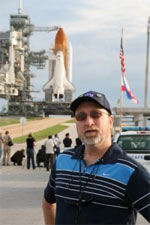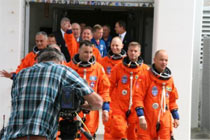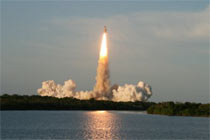Lansford assists NASA PR on shuttle Atlantis mission
By LARRY LANSFORD, APR
UF College of Education
Just a few seconds after the shuttle Atlantis thundered from its launch pad at 7:38 EDT on June 8, I continued clicking the shutter button on my Canon digital SLR as the spacecraft soared into orbit with its cargo of seven crew members. I found myself mentally willing the Atlantis higher-higher-higher through my camera viewfinder as it climbed closer to the most dangerous point in its ascent—when the solid rocket boosters separate from the orbiter.
The pivotal separation would come more than two minutes—or about 40 camera clicks—after liftoff, sparking a brief outburst of cheers and applause from the throngs of media and NASA News Center staffers and volunteers who watched or covered the historic event from the prime vantage point of the Kennedy Space Center (KSC) Press Site. The Press Site, barely three miles from the seaside launch pad, is the closest viewing site available for shuttle launches.
As a former reporter, I was surprised at how moved I became at the moment of liftoff. I morphed emotionally from professionally detached observer to sentimental slob. I felt relief—that shuttle mission “STS-117” seemed to go off without a hitch; I experienced pangs of patriotism that I’d not felt since 9-11; and I was bursting with bust-my-buttons pride, not only in the U.S. space program, but also in the small—and I mean VERY small—role I played in this historic event.

Larry at shuttlecraft Atlantis launch pad, 7:30 AM, morning of launch, with contingent of international media.
I staked my claim to this prime launch-viewing spot by working as a KSC Press Site “event volunteer,” made possible through an arrangement between NASA Public Affairs and the Florida Public Relations Association, of which I am a member. The idea was to enlist genuine public relations pros from FPRA chapters as Press Site volunteers to assist in managing the massive throngs of media during launches, which sometimes draw more than 1,000 reporters and cameramen. For the Atlantis mission, NASA sent e-mails a couple months in advance to FPRA’s 1,500 state members soliciting interested applicants. More than 100 members applied and as one of the first to respond (within T-plus 4 minutes), I was fortunate enough to be selected—and to witness the textbook launch of Atlantis.
NASA veteran staffers and a cadre of retired-employee volunteers on hand were describing it as the most picture-perfect launch they’d observed in quite some time. Later examination of post-launch video footage revealed that some foam did come off the ship’s external fuel tank during blastoff, but it posed no threat to the orbiter. I joined the parade of reporters and NASA staffers marching back into the NASA News Center. Our jobs weren’t finished. A post-launch press conference would follow within the hour, and reporters got a head start on the frenetic filing of news reports from the rows of computer work stations set up for the worldwide media corps. I silently mocked myself for feeling like I actually played a meaningful role in the launch. Nothing could be further from the truth. But the NASA News Center staff made us four FPRA volunteers feel like we were a big help in managing the 450 or so reporters who covered the event.
My volunteering stint started on a Wednesday, two days before Friday’s scheduled launch. Orlando FPRA volunteer Bill Randolph was already on his third day, and this was his fifth launch—so he served as my mentor and “commander” (as I dubbed him) of our volunteer crew. Two other FPRA volunteers—from the Space Coast and Orlando chapters—would join us on launch day. Bill introduced me to Pat Christian of NASA Media Services, who headed up the volunteer crew, gave me a quick tour of the NASA News Center building and grounds, and quickly put me to work at the media information desk. A capsule (space pun intended) summary of our responsibilities included manning the phones, posting the day’s media events and steering reporters and camera crews to the appropriate NASA staffer or media bus stop, accompanying reporters to astronaut interviews and escorting all international media between the news center and the off-site Media Badge ID Station, located a couple of miles outside the Kennedy Space Center entrance check-point. Since 9-11, no international media are allowed on the KSC complex without official escort; credentialed domestic media can drive onto KSC grounds in their own vehicles and park in the news center parking lot. All media require proof of press credentials and media badges.)

I had prime, head-on view (behind NASA pool videographer) of shuttle crew members leaving their astronaut quarters to board the NASA RV transporter that would take them to the launch pad—about 3.5 hours before liftoff. Several hundred photographers and NASA staff attended the “astronaut walk-out.”
Below, I’ll adopt my blog-filing persona to convey some snapshot observations from my three days as shuttle launch News Center volunteer:
Volunteer Day One (Wednesday, T-minus 2 days before launch):
- Following fellow volunteer Bill Randolph’s guided tour of the news center, I spent most of morning familiarizing myself with the NASA/Shuttle info notebook at the Media Info Desk, all the while answering phones (from media and the public) and pointing incoming media to the check-in office. The “Volunteers’ Bible” (my term for the priceless notebook) was chock full of fact sheets and bulleted lists both on the Atlantis launch and the 116 shuttle launches preceding it. It included a phone directory of all key NASA staffers, and maps of the space center complex. (Sample notebook factoid: The massive “Crawler” Transporter, used to roll the shuttlecraft to the launch pad, has a leveling system designed to keep the top of the space shuttle vertical while negotiating the 5 percent grade leading to the top of the launch pad.)
- After lunch in the break room with other NASA staffers, I made my first media-bus runs picking up international media at the badge ID station, first while shadowing “Cmdr. Bill” and then “flying solo.” I had to display corresponding ID numbers on my News Center ID badge and a large “NASA Media Bus” placard to check-point security guards as we entered and left the KSC grounds. Every few runs they’d pull the bus over and check the media credentials of all media-passengers aboard.
- We volunteers were pretty much left to our own devices at the media desk. NASA staffer Pat Christian was across the room if needed, and I’m sure the presence of five-launch veteran volunteer Bill Randolph was a factor. A couple retired NASA old-timers (as they called themselves) were usually on hand, too, including the retired head of NASA public affairs. Bill had compiled an orientation notebook for “rookie” media center volunteers, listing the best deals on nearby motels, what to wear (dress casual, preferably with polo shirt and decent pants like the NASA staffers wear), the type of duties to expect and other practical information nuggets. NASA truly relied on us FPRA volunteers to use our PR experience and savvy in handling the (usually) routine stuff so they can focus on the “big-picture” issues.
- Manny Virata, KSC media logistics operations manager—the veritable “ringmaster” of the shuttle launch media circus—gave Bill and me a personal, behind-the-scenes tour of the 3-mile-radius “restricted blast area” encircling Launch Pad 39A, including the shuttle landing runway, air traffic control tower and the astronaut family viewing area. The blast area includes portions of a scenic national wildlife refuge that is home to more than 500 species of wildlife and lush green foliage. We also passed by the neon-green, armored tanks poised for launch pad rescue if needed, and the delta-tailed Gulfstream jets the shuttle pilots use to train for actual “spaceplane” flight.
- My first workday ended at about 6:30 p.m., and I enjoyed the new (to me) scenery of the 13-mile trip south to the three-star Best Western-Cocoa Beach hotel, where my wife and I stayed on our four-night visit.
Volunteer Day 2 (Thursday, T-minus 1 day before launch):
Since I toured the blast area on Day 1, I bypassed the 6:30 a.m. remote camera set-up. That’s when the media bus takes the pool photographers and TV camera crews—from the major media outlets such as Associated Press, Reuters, CNN and the network television news programs—into the restricted blast area to set up their remote-controlled equipment at camera observation sites closer to Launch Pad 39A.
- I spent more time today on the international media bus than at the press information desk. Media came as far away as China, Spain, Italy and Germany, and I enjoyed my conversations with them on the bus ride about their trip, whether they’d covered previous missions (many had), and the media outlets they worked for. A few remembered my name throughout the week and sought me out later for farewell handshakes and even a hug or two after the launch. While a few reporters got a bit pushy at times—jockeying for seats on the media bus, prime picture-taking positions and primo interviews with top NASA staffers and astronaut—there seemed to be a mutual respect between the press and the NASA News staffers. Many have shared the experience of multiple shuttle launches and, for some, even the dark memories of the 1986 Challenger and the 2003 Discovery shuttle disasters. I saw members in both camps cheer after the successful blastoff of Atlantis, and I would guess there were shameless tears shed on both sides of the press room when two earlier shuttle missions ended prematurely in tragedy.

And we have liftoff… Photo shot from Kennedy Space Center Press Site, a little over 3 miles from launch pad.
I felt I made my greatest impact in mid-afternoon on Day 2, when I pointed out to “ringmaster” Manny that a decision to start the international media bus runs to and from the media check-in station at 8 a.m. the next morning would mean the foreign press corps would miss the 7 a.m. media bus trip to Launch Pad 39A. That would be their first and only unobstructed, close-up view of the Atlantis standing solo on the launch pad—the shuttlecraft having been disconnected the previous night from permanent ground-support equipment encircling the orbiter. Manny immediately got on his cell phone and arranged to have the buses start their circuitous route at 6:30 the next morning. I’m sure the NASA news crew would have realized the scheduling snafu soon enough, but perhaps my actions saved at least a little embarrassment or temporary ill will between the global press corps and the NASA News Center team. At the very least, perhaps it helped justify NASA’s decision to use genuine public relations professionals as volunteers on the Media Desk.
- I enjoyed watching how the press corps members interacted with each other and with the NASA staff. Many in both camps knew each other from previous launches, and there was plenty of good-natured ribbing and sharing of media “war” stories. A couple newspaper reporters complained about having to “do it all” in this era of multimedia coverage, with their media conglomerate employers expecting them to file video stories or blog entries along with their newspaper accounts. One reporter chimed in facetiously, “yeah, and how much did they increase your salary?” A sideways nod and a scowl were the only response he got, or needed.
- The News Center closed early at 4:30 Thursday afternoon with the knowledge that a long day lay ahead on Friday—launch day.
Volunteer Day 3 (Friday, launch day):
- Friday morning started with the “camera wipe-down and battery check” around 6:15. A NASA News Center van took the pool photographers and TV camera crews back into the restricted blast zone to check the batteries and clear the morning condensation from the lenses of their remote-controlled cameras they’d set up the previous day. Then, at 7, following a “K-9 sniffer” security check of the camera bags and equipment, a media bus took photographers, reporters and NASA volunteers as far as the barb-wired fence surrounding the Atlantis, poised for liftoff a mere 100 yards further up the launch pad incline. What a magnificent flying machine! After a 20-minute photo session, Launch Pad 39A had to be vacated and cleared for security check by 8 a.m. sharp.
- Two additional FPRA volunteers joined Bill and me for launch day. Working the press desk, we coordinated media interviews with four or five astronauts throughout the day and split bus duty. The Atlantis crew members were snug in their astronaut quarters a mile or so away, so NASA was offering interviews with astronauts who would be flying future shuttle missions. Some reporters complained that these astronauts hadn’t actually experienced true space flight, so their comments would be based solely on second-hand knowledge and simulated space travel while training. A valid point, but the astronauts were all articulate, accommodating and personable and carried themselves well, from what I saw.
- Another Kodak (or Canon EOS) moment was the “Astronaut Walkout”, as the day’s “Media Events” schedule called it. About T-minus 4 hours from liftoff, the seven Atlantis crew members would walk out of the astronaut quarters and board a shiny NASA RV for the ride to the launch pad. I had a prime, front-row spot among 200 news media and NASA staffers from surrounding buildings who had gathered to cheer the astronauts on their departure.
- Precisely at 7:38 EDT, right on schedule, the Atlantis roared into the early-evening sky above a billowing cloud of smoke and steam. The awe-inspiring launch would have been the perfect ending to my adventure, but my 15-hour volunteer workday was not over yet. For the reporters, there were stories to file from their computer work stations inside the News Center. Within an hour, there would be a post-launch news conference once the top NASA and shuttle mission officials could make their way over from Mission Control Center. And finally, we would escort weary members of the international press corps back to their rental cars at the media check-in station, where they would head to Orlando Airport and home, for some halfway around the world.

Windblown remnants of the shuttlecraft’s contrail paint the early-evening sky above the NASA News Center complex about 30 minutes after launch.
For me, dead-tired hadn’t felt so good in a long time. The shuttle launching has been the highlight of my summer so far. I was so immersed in the experience, that my three-day stint zoomed by like, well, a rocket, yet the lingering afterglow made it seem like I’d been away for a month once I returned to work the following Monday back in News and Publications at the UF College of Education in Gainesville.
Mission STS-117, while not flawless, was a success, with the Atlantis crew delivering and installing a new set of electricity-generating solar panels and a 35,000-pound structural truss to the International Space Station. They also swapped out American crew members and solved a serious breakdown of Russian computers on the space station that threatened to close down the orbiting outpost. The two-week mission of Atlantis was followed by another successful launch Aug. 8 of the space shuttle Endeavour.
NASA plans about 12 more shuttle flights before the end of the shuttle program in 2010. Through my volunteer experience, I not only got to view a shuttle launch from the closest possible vantage point, but I also was able to observe how a first-class public relations outfit like NASA’s and the Kennedy Space Center’s has handled nearly 120 missions since the first operational test flight in 1981. It’s mind-boggling to consider staging multiple special events—the magnitude of a space shuttle launch—in a year’s time with each drawing hundreds of media representatives from around the globe to your place of employment. And doing this year after year for nearly three decades!
How does the NASA News Center team do it? Well, for the past five launches, they’ve done it with just a little help from FPRA. I’m glad I could help.
Larry Lansford, APR, has worked since 2004 as director of news and publications at UF’s College of Education. He also is a past president of FPRA-Gainesville Chapter. He is a former newspaper reporter and has worked in media and public relations at the University of Florida for 22 years, sandwiched around a seven-year stint as a freelance writer and public relations consultant. He previously was director of public relations at UF’s College of Medicine.




